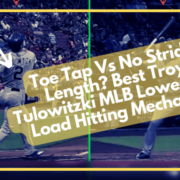Discover how much the baseball and softball toe tap, long stride length, or no stride contributes to bat speed. Does stride help to hit the ball better, farther, and with power? Learn lower half swing experiment and best load mechanics of MLB hitters…
Troy Tulowitzki Swing Breakdown: Stride Killing Bat Speed?
Question: Does Stride Length Kill Bat Speed?
Using the Zepp (Labs) Baseball app, I wanted to use the Scientific Method to analyze whether Troy Tulowitzki’s longer stride increases or decreases bat speed. Not just a longer stride, but I want to see the torso moving forward as well.
Background Research
Troy Tulowitzki had a wider stance in 2013. In 2014, he’s adopted more of a narrow stance and a longer stride length.
Forward Momentum may be a new concept to hitting, but not to other explosive rotational athletes. It’s also known as the Conservation of Linear Momentum and the Un-Weighting Principal. The idea is that the hitter is getting a “head start”. Other high level athletes using Forward Momentum:
- Olympic Throwers (Discus, Javelin, and Hammer)
- Olympic Shot Put
- 4 X 100 meter relay sprinters
- Circus Trapeze Artists
- Lacrosse Players
- Hockey Players
SCIENCE-BASED TRAINING:
Improve your hitting strategy dramatically by applying human movement principles.
Learn not only how and what to train but also the science behind the methods.
Hypothesis
I think the addition of forward momentum, or a longer stride length, will contribute to more bat speed because this gives the hitter a “head start”, making the body feel lighter while moving. This allows the body to turn harder, and ultimately increase bat speed.
Troy Tulowitzki Experiment
Equipment:
- Zepp Baseball app
,
- ATEC Tuffy Batting Tee,
- Rawlings Official NCAA Baseballs,
- Two yellow dimple baseballs,
- Galaxy S3 phone camera, and
- 33 inch, 30 ounce Pinnacle Bamboo bat.
Setup:
- Feedback markers = my bat length, plus two baseballs
- Distance from plate = end of the bat touching inside corner of plate, and knob of bat touching my mid-thigh
- NO-stride stance was width of feedback markers
- Forward movement stance was open, and feet set a little wider than shoulder width
- Tee was set a baseball or two behind the front feedback marker, and tee height was about mid-thigh
- 101 baseballs were hit using both the NO-stride and longer stride sessions
Data Collected:

Pay particular attention to the bold typeface…
Data Analysis & Conclusion

NO-stride: last 6 batted balls (Zepp Baseball app)
- 0.624 mph average bat speed increase with a longer stride.
- Apex of bell curve for NO-stride swings ranged from 77 mph to 83 mph*.
- With a longer stride, you’ll see the bell curve shifted, 81 mph to 85 mph*.
- Three more 90 mph+ swings using a longer stride, in addition to increasing my Personal Record 2 mph.
*Based on six or more batted balls repeated in specific mph (bold typeface in the chart above)
Notes

Longer Stride: last 6 batted balls (Zepp Baseball app)
- Before the experiment I did a 7 minute Dynamic Warm-up.
- I didn’t just increase my stride length, I moved my whole torso forward.
- I began the experiment with the NO-stride swings.
- I took a 20-30 minute break between the two sessions.
- During the last twenty swings of the longer stride session, I hit five-of-eight 90 mph+ balls.
From the Zepp Baseball screenshots to the right, it’s interesting to note, my bat speed kept up, even increased with forward momentum and a longer stride. In other words, I wasn’t as tired at the end of hitting over 200 baseballs.
Now that Troy Tulowitzki is using a more narrow stance and generating forward momentum with a longer stride, he’s able to increase his bat speed. This may explain the surge in opposite field home-runs in 2014.


